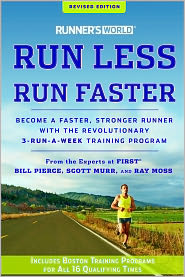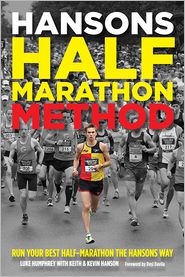There’s a big event that I’ve had on my mind for years. It’s the Gore-Tex Transrockies Run. This year’s gig is six days, 120 miles with 20,000 feet of elevation gain. I’m looking at running the 2015 race so I figure the mileage and such should be about the same. Go here for maps and descriptions of this year’s stages.
Preparation for the Transrockies run means a whole lotta running this year. I need to do more trail races and another marathon, most likely a trail marathon. I’m running a lot (for me) right now. I’m up to about 30 miles per week. I’ve got a 5k this weekend and more races planned (more on that in a moment.) The very good news is that everything is feeling solid and strong, including my stubborn, chronic Achilles/heel trouble.
I’ve also consulted with Denver-area running coach Jay Johnson. I saw him speak at the NSCA Endurance Clinic a few months ago and I became very interested in picking his brain a bit. I’ll be communicating with him every month or so to fine tune my workouts and run plan. Speaking of which…
My first and only marathon (two years ago) was based on the FIRST Run Less, Run Faster plan. This plan has only three run days per week: a track workout, tempo run, and a distance run. Two days a week were devoted to a cross-training workout on a bike or rower. I also ran the Ft. Collins Half-Marathon and Park-to-Park 10-Miler based on this plan. It’s a minimalist running plan. It’s very useful if there’s limited training time available. This plan got me through several races but I want to know if a different type of plan will increase my performance. I’m curious if more running will make me a better runner.
The Transrockies run is a lot of running for several days in a row, thus with the SAID Principle in mind, it makes sense to me that I should train in as close a fashion to the race as possible. This time around, I’m going the maximalist route with the Hansons Marathon Method. (I also need to get the Hansons Half-Marathon Method.)
Something to consider with this high-volume plan is the opportunity to practice running. That is, with all the miles and the recovery runs, I get the chance to refine my running skills. Running is a skill just like playing a horn or driving a golf ball. Running improvements don’t come just from the obvious increases in fitness that come from speed work, tempo runs and tough long runs. Matt Fitzgerald discusses this idea in a Running Times article called Rethinking Junk Miles:
You see, running is a bit like juggling. It is a motor skill that requires communication between your brain and your muscles. A great juggler has developed highly refined communication between his brain and muscles during the act of juggling, which enables him to juggle three plates with one hand while blindfolded. A well-trained runner has developed super-efficient communication between her brain and muscles during the act of running, allowing her to run at a high, sustained speed with a remarkably low rate of energy expenditure. Sure, the improvements that a runner makes in neuromuscular coordination are less visible than those made by a juggler, but they are no less real.
For both the juggler and the runner, it is time spent simply practicing the relevant action that improves communication between the brain and the muscles. It’s not a matter of testing physiological limits, but of developing a skill through repetition. Thus, the juggler who juggles an hour a day will improve faster than the juggler who juggles five minutes a day, even if the former practices in a dozen separate five-minute sessions and therefore never gets tired. And the same is true for the runner.
(BTW, Russian kettlebell and strength expert Pavel Tsatsouline discusses the exact same principle but with regard to strength training.)
The Hansons Plan has me running often in a fatigued state. The longest run I do though is 16 miles. Most marathon plans feature a 20 mile run. So why only 16 as a longest run? This 16-miler will take place after several days of running. I’ll have a tempo run then an 8 or 6 mile run the day before the 16-miler. The idea as they say in the Hansons book is that I’ll be training to run the last 16 miles of the marathon. Sounds interesting and plausible to me. That goes along with something Coach Johnson suggested. He said that at some point, in preparation for the Transrockies Run, that every other week I should run back-to-back long trail runs. Again, this goes to the idea of training specificity. I imagine I’ll do that next year.
Here’s a list of races and potential races I plan to run this year:
- 3/2/14 – That Dam 5k – Denver: I need to run a 5k so I can derive my training paces for the marathon plan.
- 4/6/14 – XTERRA Cheyenne Mt. Trail Run 12km – CO Springs: Don’t know anything about this race but I’m looking fwd to it.
- 5/4/14 – Ft. Collins Marathon 13.1: Ran this one last year and had a great time. Went out a tiny bit too fast though. Hope to better my time of 1:47.
- 6/7/14(maybe) – Boulder Sunrise Duathlon 3.1 mile run / 17.3 mile bike / 3.1 mile run – Boulder: My wife is doing this triathlon. I don’t swim well enough to do a tri but I’ve done some duathlons and this might be fun and a change of pace.
- Summer – 5k: Coach Jay Johnson suggested I train for and race a 5k. He said putting in that speed work would be useful for a Fall marathon.
- 8/23/14 (maybe) – Continental Divide Trail Race 15.5 mi. – Steamboat: Ran this one a couple of years ago and it was brutal but beautiful and a very laid-back kinda thing. Wouldn’t mind taking it on again in a better pair of shoes. Not sure if this one fits into the overall race plan.
- 9/20/14 – Aspen Golden Leaf Trail Half-Marathon – Aspen: This race got a great write-up in some running magazine (Runner’s World? Competitor?) recently. We’ve never been to Aspen. Sounds interesting. Should be good preparation for the marathon.
- 11/8/14 – Moab Trail Marathon: This is my main race. We’ve never been to Moab and this is a great reason to go.
That’s my plan right now. I’m very excited about this! I’m feeling great right now. I really love the process of getting to these races. I love the anticipation and the training. We’ll see what happens.



